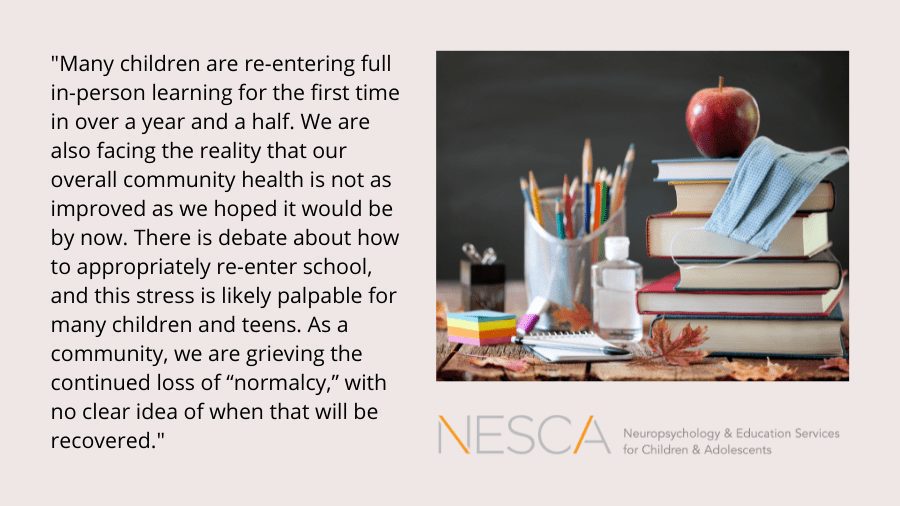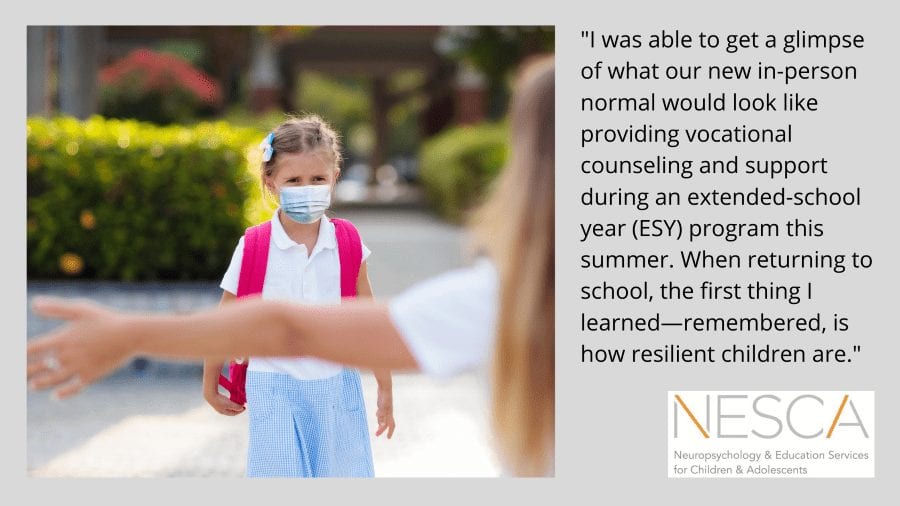
 By: Renee Cutiongco Folsom, Ph.D.
By: Renee Cutiongco Folsom, Ph.D.
Pediatric Neuropsychologist
I know that summer is about to end here in New England when I see posts on Facebook from my West Coast friends about their children’s first day of school and when every other commercial on TV is heralding back-to-school sales. A little sense of panic sets in, because of all the preparations needed for children going back to school. In my work with children with special needs, one group that often struggles with transitions such as these is children with Autism Spectrum Disorder.
Autism Spectrum Disorder (ASD) is a developmental disorder that manifests in challenges with social communication and interaction, and in the presence of repetitive, restricted behaviors that significantly impact functioning. One of the symptoms of ASD is difficulty with transitions. Some children with ASD get really upset with even slight changes in routines or plans. This is the reason why the start and end of the school year is often difficult for them. Here are some strategies for helping children with ASD transition back to school. They can also be used for any child to prepare for any transition, major or minor.
Visit the new school/classroom – A lot of schools are already doing this, but a visit to a new school or classroom a few days before the official start of school could help your child get acclimated to their new environment or teacher. Teachers usually report for work the week before the first day of school to prepare their rooms. Set a time to meet with the new teacher and let them provide your child with a tour of the room and other areas, such as the library or cafeteria. Show the child their desk and cubby. Tell them about the schedule posted on the board. This will ease some of your child’s fears and anxieties about the first day of school.
Use social stories – Social stories are written or illustrated stories that present information about social situations. Developed by educational consultant, Carol Gray, they instruct students about what to do or say in social situations, for example, the first day of school, together with information about other people’s motives or expectations. Using pictures from the school visit above, you can create a social story about the first day of school that talks about what to expect, directives about what your child can do or say, and the reason behind these actions. Here is an example of part of a social story for the first day of school:
- This is Ms. Smith, my new teacher. She is very nice.
- My mom and I walk to my classroom.
- Smith is there to greet me. I look at her and smile.
- I say goodbye to my mom and give her a big hug. She will come back at the end of the day to pick me up.
- I enter the room and place my bag in my cubby. I find my desk and take my seat.
- I look at the kid next to me and say, “Hi.” I want other kids to like me.
For help with creating social stories, you can go to https://carolgraysocialstories.com/social-stories/what-is-it/ or https://www.autismspeaks.org/templates-personalized-teaching-stories.
Use video modeling – In my work with children with autism, I often find that they are visual learners; they have better developed abilities in thinking and reasoning with pictures. And with the popularity of technology, such as iPads and smartphones, they are usually attracted to videos. Speech and language pathologist Linda Hodgdon, M.Ed., CCC-SLP (www.usevisualstrategies.com) has developed a strategy of using videos to teach skills/competencies for children and adolescents with ASD. In video modeling, you can bring your child to the new school/classroom a few days early with a video camera. You can record walking the hallways from class to class, opening the locker, going to the cafeteria or the gym, and other things they would need to do when school is in session. While you are filming, you can add dialogue explaining each item or place of interest. Then, your child/teenager can watch the video at home to prepare for the first real day of school when students will be there. Video modeling can also be used to prepare for other transitions/novel situations, such as preparing for a holiday or a new experience (e.g., riding a train, watching a movie, visiting a new restaurant).
Transitions are difficult because they require us to leave a place or state that we have been accustomed to and enter something that is unknown or unpredictable. Preparing ourselves for transitions by demystifying some of the unknowns can help us cope better with the anxiety that is inherent in these situations. I hope the suggestions above can help you and your child transition back to school.
About the Author
Dr. Renee Cutiongco Folsom, Ph.D. has been working with families in the greater Boston area since 2015. Prior to this, she was on staff at Johns Hopkins University and trained at the University of California, Los Angeles (UCLA). She provides comprehensive neuropsychological evaluations of children, adolescents, and young adults who have learning, behavioral, and socio-emotional challenges. Her areas of expertise include Autism Spectrum Disorder and other conditions that usually co-occur with this diagnosis; Attention-Deficit/Hyperactivity Disorder; Dyslexia and other Specific Learning Disabilities; and Anxiety/Depression. She thinks that the best part of being a pediatric neuropsychologist is helping change the trajectory of children’s lives.
staff at Johns Hopkins University and trained at the University of California, Los Angeles (UCLA). She provides comprehensive neuropsychological evaluations of children, adolescents, and young adults who have learning, behavioral, and socio-emotional challenges. Her areas of expertise include Autism Spectrum Disorder and other conditions that usually co-occur with this diagnosis; Attention-Deficit/Hyperactivity Disorder; Dyslexia and other Specific Learning Disabilities; and Anxiety/Depression. She thinks that the best part of being a pediatric neuropsychologist is helping change the trajectory of children’s lives.
To schedule an appointment with one of NESCA’s pediatric neuropsychologists, please complete our online intake form.
NESCA is a pediatric neuropsychology practice and integrative treatment center with offices in Newton, Plainville, and Hingham, Massachusetts; Londonderry, New Hampshire; the greater Burlington, Vermont region, and Brooklyn, NY, serving clients from infancy through young adulthood and their families. For more information, please email info@nesca-newton.com or call 617-658-9800.


 and academia for over 30 years. She is a national consultant and speaker on program design and the inclusion of children and adolescents with special needs, especially those diagnosed with Autism Spectrum Disorder (ASD). Prior to joining NESCA, Ms. Lucci was the Principal of the Partners Program/EDCO Collaborative and previously the Program Director and Director of Consultation at MGH/Aspire for 13 years, where she built child, teen and young adult programs and established the 3-Ss (self-awareness, social competency and stress management) as the programming backbone. She also served as director of the Autism Support Center. Ms. Lucci was previously an elementary classroom teacher, special educator, researcher, school psychologist, college professor and director of public schools, a private special education school and an education collaborative.
and academia for over 30 years. She is a national consultant and speaker on program design and the inclusion of children and adolescents with special needs, especially those diagnosed with Autism Spectrum Disorder (ASD). Prior to joining NESCA, Ms. Lucci was the Principal of the Partners Program/EDCO Collaborative and previously the Program Director and Director of Consultation at MGH/Aspire for 13 years, where she built child, teen and young adult programs and established the 3-Ss (self-awareness, social competency and stress management) as the programming backbone. She also served as director of the Autism Support Center. Ms. Lucci was previously an elementary classroom teacher, special educator, researcher, school psychologist, college professor and director of public schools, a private special education school and an education collaborative.
 Zeitler joined NESCA full-time in the fall of 2020 to offer occupational therapy assessment and treatment for children of all ages, as well as to work in conjunction with Abigael Gray, MS, CCC-SLP, on the feeding team.
Zeitler joined NESCA full-time in the fall of 2020 to offer occupational therapy assessment and treatment for children of all ages, as well as to work in conjunction with Abigael Gray, MS, CCC-SLP, on the feeding team.
 Londonderry, NH office. She specializes in the evaluation of anxious children and teens, working to tease apart the various factors lending to their stress, such as underlying learning, attentional, or emotional challenges. She particularly enjoys working with the seemingly “unmotivated” child, as well as children who have “flown under the radar” for years due to their desire to succeed.
Londonderry, NH office. She specializes in the evaluation of anxious children and teens, working to tease apart the various factors lending to their stress, such as underlying learning, attentional, or emotional challenges. She particularly enjoys working with the seemingly “unmotivated” child, as well as children who have “flown under the radar” for years due to their desire to succeed.
 unique pattern of strengths and weaknesses to best formulate a plan for intervention and success. With experiences providing therapy and assessments, Dr. Creedon bridges the gap between testing data and therapeutic services to develop a clear roadmap for change and deeper of understanding of individual needs.
unique pattern of strengths and weaknesses to best formulate a plan for intervention and success. With experiences providing therapy and assessments, Dr. Creedon bridges the gap between testing data and therapeutic services to develop a clear roadmap for change and deeper of understanding of individual needs.




Connect with Us